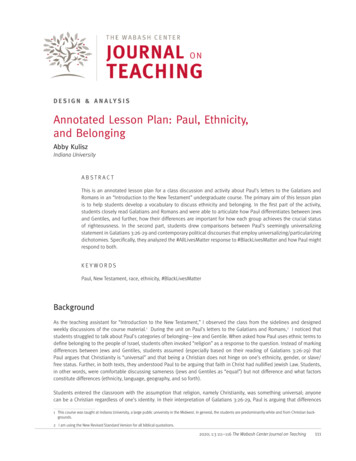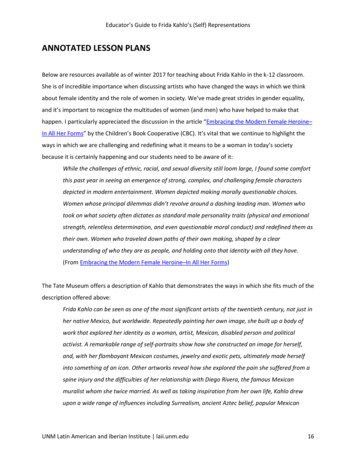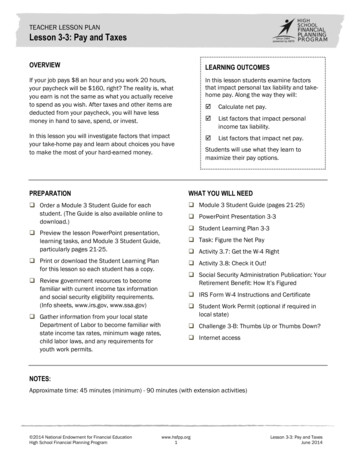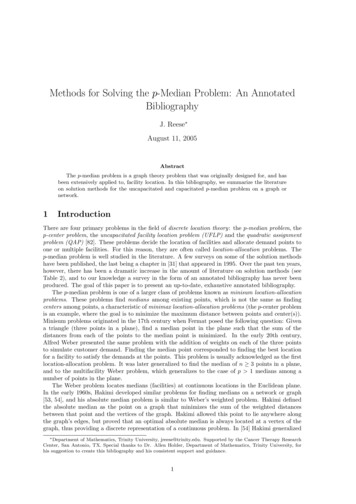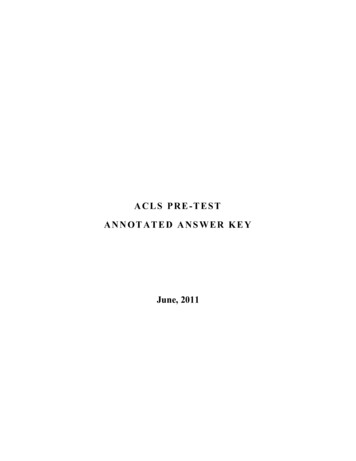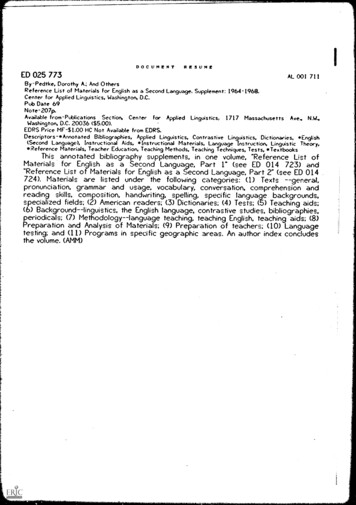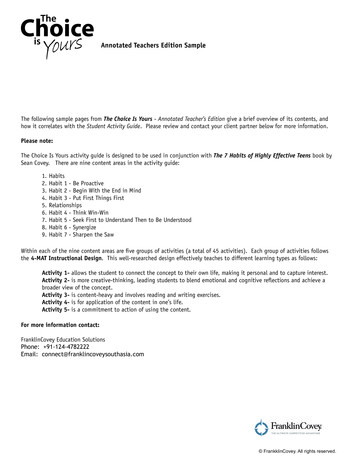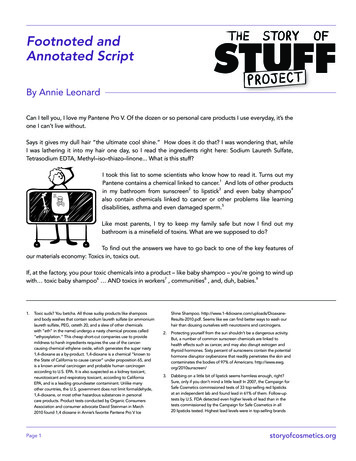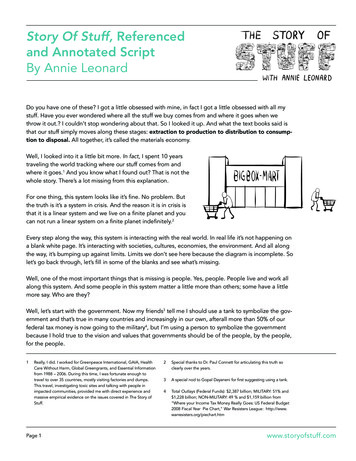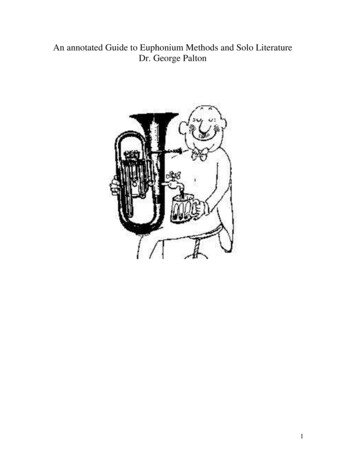
Transcription
SHAPING THE WAY WE TEACH ENGLISH. 1. THE LANDSCAPE OF ENGLISH LANGUAGETEACHINGLarisa IshchenkoPHASE 1 LESSON PLAN TEMPLATEDirections:Use this Template to fill out your lesson plan. (Add more space to any section if you need it.)Don’t forget the reflection at the end (part F), as well. Refer to the rubric to be sure you haveincluded all elements.A. Students and Setting:Students: Briefly identify the age, grade level, and previous English experience of your students. Includeanything that would help other teachers understand who your target students are.The ninth grade teenagers (ages 13-14) with Pre-Intermediate language proficiency, who havebeen studying English for four years in a Russian-Ukrainian – speaking environment.Setting: Include the type of institution (private school, public school, university, other institution?) Includethe number of students in the class. State how often the class meets and for how long. Please includeanything that will help other teachers understand the situation where the lesson will be taught.This is a comprehensive (public) school where English is taught two times a week. There are 1415 students in the class. Every lesson lasts 45 minutes. The classroom is adequately resourced.There is a computer with access to the Internet, a smart TV and a whiteboard. The students havetextbooks of one of the famous British publishers. Most of the students use IPads, IPhones andtablet PCs.B. Lesson Background:Describe briefly what kinds of lessons have immediately preceded this one. Are you expanding apreviously learned/practiced point? beginning a new module? offering extended practice? Describe brieflywhat will happen following this lesson. Are you expanding or continuing practice?If this is the first or the final lesson, be sure to say so. Include anything that will help teachers to visualizethe lesson context.This integrated skills lesson with extended listening skills and vocabulary work is the first in thethematic unit “Technology in our life” (the unit consists of eight lessons). At the followinglessons students will take part in a group discussion, assume a monitoring role and make a shortpresentation to the class. The theme of the last lesson of the unit is ‘Learning English withTechnology – My Choice”. Students are to make a 3 min video (individually, in pairs or groups) inwhich they will talk about gadgets and explain how they can use technology in learning English inclass or beyond it.C. Learning Objectives/Expected Results:Describe how students will improve or change as a result of this lesson. Include what students will beable to understand and DO as a result of the lesson.The students will increase , demonstrate listening comprehension of the dialogue for specificThis is a program of the U.S. Department of State, administered by the University of Oregon.MOOC Shaping the Way We Teach English. Copyright 2015 University of Oregon. All rights reserved.Phase 1 Lesson Plan TemplatePage 1
information , developAt this lesson the students learn and practice vocabulary related to gadgets and appliances.As a result of the lesson my students will be able to talk, express ideas, give and justify theiropinions on things read, seen, heard and viewed using appropriate language in oral and writtenformat during individual and pair work. The students will also be able to give articulateinstructions on using gadgets and appliances.D. Materials and Sources:.Materials: List any objects or realia that you need to make or collect. List any authentic materials that willbe used, and whether you need to prepare or enhance them beforehand. List any needed worksheets orwritten instructions.Be sure that any materials you mention in the Procedures section are also listed here. Include worksheetsor handouts as attachments.Prepared beforehand: Virtual/Digital representations of realia (Pic.1, Pic. 1.1) A Handout and a Worksheet. One copy of each for a student Cards with the names of objects Students will need their notebooks to hand in to the teacher at the end of the lesson andblue pens.A computer , a TV, access to the Internet, a blackboard and a piece of chalkSources: List where your materials or realia came from so that others may find them.Shaping the Way We Teach English, 1: The Landscape of English Language Teachingby Dr. Deborah Healey, Jeff Magoto, Dr. Elizabeth Hanson-Smith, Week 1 Introductory video at pe-002/lecture/7Rivera, C. (2006). Classroom techniques: Communicative activities for middle school classrooms. EnglishTeaching Forum, 44(2), 34-36. Retrieved urce files/06-44-2-h.pdfCathy Allen Simon. Using the Think-Pair-Share Technique – r-share30626.htmlBBC News Click Video Ask a Wrist Watch Complex arah Cunningham, Peter Moor, Real Life Pre-Intermediate Students’book : Pearson, 2012.The pictures are taken from the Internet ( Google, Pinterest, Flickr)E. Procedures / Timing:List step by step what you will do in class, and what you expect the students to do. How will you provideopportunities for students to talk to each other, for example with group or pair work? Make sure that youinclude the use of authentic materials/realia AND pair/group work appropriately. Be sure the time that isallocated is appropriate. The reader needs to be able to visualize how the lesson will proceed.Your lesson should be about 40-60 minutes long. Try to divide the steps logically, where the teachermoves to a different activity.Procedures / Timing: Use the table below. Each new action by the teacher can be a separate rowin the table if you have enough rows. Remember to do Section F, Reflection, at the bottom of thepage.This is a program of the U.S. Department of State, administered by the University of Oregon.MOOC Shaping the Way We Teach English. Copyright 2015 University of Oregon. All rights reserved.Phase 1 Lesson Plan TemplatePage 2
Teacher does/says . . .Students do/say . . .Starts the lesson with askingthe students a question andsets the task.What electrical and/orbattery operated objects doyou use every day? In 30sec one representative ofeach pair in turn has to cometo the blackboard to writeone word from the listsyou’ve written. Make sureyour word hasn’t beenwritten before. We can haveseveral rounds to make thelist on the blackboard assoon as possible.Asks the pair that hasn’tcome to the blackboard (ifany} to read their list ofwords to the class.Make lists of objects in pairs. Thena student from each pair writes onenew word on the blackboard.One pair of students has no wordsto write, because all their words arealready written. They read thewords to the class.Sets the situation.Choose the objects, discuss inYou have a chance to takepairs and share their ideas withpart in the reality showother studentsSurvivor. Look at the list ofthe words written on theblackboard and choose threeobjects you think you needmost of all. Name the objectsand explain why you’vechosen them in particularaccording to the model:Writes on the blackboard:If I take part in the realityshow Survivor, I willtake ,because it .Exchange your ideas withthe partner and present themto the classMonitors.Approximate timeneeded5 min4 minThis is a program of the U.S. Department of State, administered by the University of Oregon.MOOC Shaping the Way We Teach English. Copyright 2015 University of Oregon. All rights reserved.Phase 1 Lesson Plan TemplatePage 3
Displays the Pic.1 from his/her Materials, prepared forthe lesson, on the TVscreen.Please, look at the TVscreen. You can see thepictures of eight gadgets andappliances. You shouldmatch the pictures of thegadgets with their names.(figure – letter)Every time the studentsannounce the answer, theteacher shows the correctone on the screen (Pic.1.1)Match the pictures to theirdefinitions in pairs and say theirvariant of choice aloud.One – c, etc.Check the answers looking at theTV screen7 minOffers students to selectthree gadgets/appliancesthey think are the mostnecessary ones in real life,and to write sentences withthem.You should choose threegadgets and write threesentences in your notebooksexplaining why you thinkthose gadgets/appliancesare important in real life. I’llwrite you the model on theblackboard.Writes the model: I thinkfridges are the mostimportant appliances ofall, because if we didn’thave them our food wouldspoil very quickly.Choose three gadgets and writethree sentences into theirnotebooks.5 minDistributes Handouts.Read the sentences aloud.Asks the students to repeatthem after him/her andRead the sentences, repeat thewords after the teacher and explaintheir meaning physically.5 minThis is a program of the U.S. Department of State, administered by the University of Oregon.MOOC Shaping the Way We Teach English. Copyright 2015 University of Oregon. All rights reserved.Phase 1 Lesson Plan TemplatePage 4
explain the meaning of thehighlighted words usinggestures, mimic, etc.Puts Worksheets on thestudents’ desks. Reads thetask.Complete the explanationsof how two gadgets work.What are they?Checks the answerstogether with the students.Complete the texts individually.Then check in pairs and with theteacher.6 minDisplays the phrases (Pic.2)on the TV screen. Offerseach pair of students tochoose a card with the nameof a gadget (the studentsdon’t know which word iswritten on a card)Can anybody guess?Read and repeat the phrases inturnsEach pair chooses a card with thename of a gadget. Describe how touse it Other students try to guess.6 minShows a video.(Pic.3)Watch the video, put down someNow we’ll watch a 2 minnotes. Answer the questions.video from BBC NewsChannel about a newgadget. When watching it putdown some information intoyour notebooks. Watch theVideo and answer thequestions:What is its name? What is itfor? Would you like to havesuch a gadget and why?5 minAsks the students what theyhave learnt at the lesson.Collects students’ notebooksGives the assignment for thenext lesson2 minGive feedback to the teacher in theform Can Do sentencesTotal: 45 minThis is a program of the U.S. Department of State, administered by the University of Oregon.MOOC Shaping the Way We Teach English. Copyright 2015 University of Oregon. All rights reserved.Phase 1 Lesson Plan TemplatePage 5
F. Reflection - Week 2:Describe how this lesson demonstrates the use of realia and/or authentic materials and pair or groupwork. Explain how this lesson is appropriate to the age/grade level of student you are targeting.My students’ main difficulty in their English language learning is the ability to speakfluently. That is why I’ve been trying to find such methods and technologies that can helpthem to solve that problem in the best way.At the lesson my students work in pairs. This enables them to compare answers andclarify problems together using English.Someone said that to learn anything fast and effectively you have to see it, hear it, andfeel it. I have noticed that using authentic materials and/or realia in teaching English canimprove students’ speaking greatly.In the lesson I use virtual (digital) representations of realia. The students will be able to usethose images in their presentations and videos for the final lesson.This lesson is performed according to the curricular and the CEF standards. The sphere ofcommunication, vocabulary and grammar is appropriate to this age/grade level of student I ’mtargetingATTACHMENTSPic. 1Gadgets and Appliances13This is a program of the U.S. Department of State, administered by the University of Oregon.MOOC Shaping the Way We Teach English. Copyright 2015 University of Oregon. All rights reserved.Phase 1 Lesson Plan TemplatePage 6
245678This is a program of the U.S. Department of State, administered by the University of Oregon.MOOC Shaping the Way We Teach English. Copyright 2015 University of Oregon. All rights reserved.Phase 1 Lesson Plan TemplatePage 7
abcdefgha pendrivea digital cameraa mobile phonea smart TVa vacuum cleanera hairdryera games consolean MP3 playerPic. 1.11- ca mobile phone3-d2-ba smart TVa digital camera4-fa hairdryerThis is a program of the U.S. Department of State, administered by the University of Oregon.MOOC Shaping the Way We Teach English. Copyright 2015 University of Oregon. All rights reserved.Phase 1 Lesson Plan TemplatePage 8
5–ga games console6 -h7–aa pendrive8–ean MP3 playera vacuum cleanerPic. 2Giving instructionsFirst of all, you switch it on.Then you select from the menu.You have to charge the battery/it.Just follow the instructions.Don’t forget to switch it off.This is a program of the U.S. Department of State, administered by the University of Oregon.MOOC Shaping the Way We Teach English. Copyright 2015 University of Oregon. All rights reserved.Phase 1 Lesson Plan TemplatePage 9
Pic.3The VideoHANDOUTRead, Repeat, Explain1. It doesn’t work. You’ve forgot to put batteries in it.2. “Please, plug my hairdryer in”, said the mother.3. You charge the battery using a charger.4. The TV can be switched on and off with a remote control.5. You press a button to turn the volume up or down.This is a program of the U.S. Department of State, administered by the University of Oregon.MOOC Shaping the Way We Teach English. Copyright 2015 University of Oregon. All rights reserved.Phase 1 Lesson Plan TemplatePage 10
6. You select from the menu.7. It can record messages.8. “Nick, before going to bed don’t forget to set the time onyour alarm clock to get up on time”, said the father .WORKSHEETComplete the explanations of how two gadgets work. What are they?1.First of all, you need to plug it 1. in and press the button to switchit 2. . Then you need to 3. the time. If you have anymessages, you 4. the button to listen to them.2.Before you use it for the first time, 5. the battery for
PHASE 1 LESSON PLAN TEMPLATE Directions: Use this Template to fill out your lesson plan. (Add more space to any section if you need it.) Don’t forget the reflection at the end (part F), as well. Refer to the rubric to be sure you have included all elements. A. Students and Setting:
